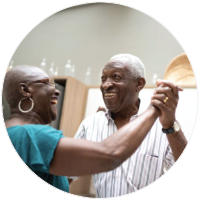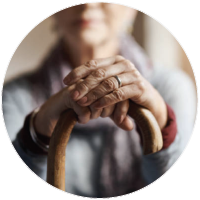
By Naomi Karp, Consulting Research Scholar, Stanford Center on Longevity
My 95-year-old mother lives in an independent living facility a ten-minute drive from my home. It’s a sixteen-story high-rise owned by a corporate chain that has 260 senior living communities. In exchange for monthly rent, she has a spacious apartment, house-cleaning services, meals, and—at least until the coronavirus struck—all sorts of activities inside and outside the building.
My mom didn’t want to live here. After fleeing Nazi Germany as a teenager, she lived in New York City for over 70 years, raised a family, and worked as a librarian until she was 75. After retiring, she volunteered at an archive of German Jewish history, and enjoyed opera, book groups and synagogue. She made new friends into her 90s. About five years ago, her memory began slipping: she forgot to meet friends as planned, and burned things on the stove. With neither of her two children living nearby, it was not a good situation.
So, like so many of her peers, she let us cajole her into moving. The views of the trees and golf course are expansive, but there’s nowhere to walk and few services nearby. She was depressed but remained engaged, heartbreakingly eager to make new relationships but limited due to her cognition. Over time, her memory and thought processes declined. While physically healthy, her dementia and frailty have necessitated round-the-clock help. We’re lucky she can afford it. We’ve avoided institutional care by turning her “independent living” home into a supportive environment. It has been achingly sad to watch the changes in my once vital and verbal mother, but we’ve managed.
We didn’t anticipate Covid-19, though. As a caregiving daughter and as a professional in the aging arena, I’m learning some lessons.
Like so many residences for older adults, my mom’s place went into lockdown in March, 2020. Unlike at nursing homes, this action wasn’t mandated by the federal government. Management prudently followed CDC and state guidelines. For three months or so, the only people entering were “essential personnel” and family members in urgent situations.
Almost all normal activities stopped: the dining room closed, and staff delivered monotonous meals to apartments, cancelled cultural programs, closed the pool, and ended club room cocktails and excursions to museums. They didn’t provide Covid-19 testing or other health services nor offer much communication with residents and families. Residents were essentially locked in their apartments with little structure to their lives. My mom became more confused and physically weaker from inactivity. COVID stayed away almost entirely.
The pandemic is teaching us that while older adults living in congregate settings may be best protected from highly communicative diseases like Covid-19 through lockdowns, they suffer in other ways–mentally, emotionally and physically. Most congregate facilities are structured in ways that may exacerbate these effects—and often provide few services to mitigate them. Physical distancing is the key to keeping residents safe, as one operator of a senior living facility observes, but social distancing rapidly leads to physical and cognitive decline. Some facilities saw residents losing 5% of their body weight.
Residential models for older adults have changed as people live longer, the economy and financing morphs, labor shortages occur and technology enables people to stay in their homes longer. Decades ago, assisted living and memory care residences began housing people with cognitive decline and physical disability or frailty who were previously found in nursing homes. After the 2008 financial crisis, older people delayed leaving home; they moved into senior living settings at older ages. As one industry expert puts it: “Independent living looks like assisted living 10 years ago and assisted living – not the nursing home – is the last home for many.” And, for my mom and many others who can afford to hire caregivers, independent living may be the last stop.
The pandemic may deter some people from moving into congregate settings, but the demand is likely to persist. Some people can’t stay at home; others relish the social connections of congregate living. But places like the one in which my mom lives must adapt to current realities and future trends. Even after the virus recedes, the world will not revert to pre-Covid conditions.
So what might the future look like?
Smaller, homier facilities, to include housing “pods”
 The health and wellness of older adults can be enhanced by designing — or redesigning — congregate facilities to provide smaller, more connected communities. These small residences could be completely free-standing, or they could be sub-units or “pods” within a larger building or campus. Some existing facilities, although not built for small modules, might be adapted to accommodate this type of social structure and service delivery model.
The health and wellness of older adults can be enhanced by designing — or redesigning — congregate facilities to provide smaller, more connected communities. These small residences could be completely free-standing, or they could be sub-units or “pods” within a larger building or campus. Some existing facilities, although not built for small modules, might be adapted to accommodate this type of social structure and service delivery model.
Residents could have single rooms or apartments for privacy and for isolation when necessary, but also have communal living rooms, kitchens, and dining areas where residents and staff interact. Each pod could have dedicated, full-time staff, who play multiple roles rather than one single job description (e.g. kitchen staff, housekeeping, health aide). Staff could get to know residents better, and could help individuals to maintain preferred, and perhaps lifelong, daily routines and activities. People living in these smaller settings also would be able to develop more consistent relationships with their fellow residents and not fall through the cracks if they are more introverted or less “popular.”
This approach might slightly increase risks of illness compared to fully autonomous apartments because there would be interaction within the pods. Risks could be minimized by good public health practices and compensated for by benefits of more socialization, individual attention from staff, and less isolation. Also, breaking larger facilities into smaller self-contained units could keep Covid-like diseases from spreading as widely as in a large facility with free movement throughout.
The Green House Project, a non-profit that aims to destigmatize aging and humanize care, provides a model. Green House homes typically house eight to ten residents. Over the past 17 years, 300 nursing homes and assisted living facilities have been built based on this concept.
A recent Washington Post article reported that Green House residents are one-fifth as likely to get the coronavirus as those who live in typical nursing homes, and one-twentieth as likely to die from it. Academics and doctors have praised this model, yet only a tiny fraction of senior living facilities have adopted it.
A variant of the “pod” model is cohousing. Senior cohousing communities are a form of communal living that integrates common areas and private residences. Typically, the communities are small and are planned, developed and operated by the residents. Residents buy their units, share indoor and outdoor spaces, and generally are required to work and participate in governance of the community. These communities likely are most successful for a younger, healthier cohort of older adults, but some senior cohousing communities have hired shared medical professionals or caregivers.
Physical design of interior and exterior space to maximize health and safety
 A task force of senior living industry leaders and analysts recently made recommendations on designing and redesigning exterior and interior space. Their ideas included:
A task force of senior living industry leaders and analysts recently made recommendations on designing and redesigning exterior and interior space. Their ideas included:
- installing air filtration systems to reduce airborne transmission of disease
- minimizing touch using devices like automatic doors and voice-activated lighting
- creating and designating areas that can be used for isolation
- reimagining and increasing the amount of outdoor space
This last point is especially important. From Spring through Fall of 2020, I visited my mom outdoors. My ability to see her has been constrained by the weather, by her ability to walk long distances, and by the narrow walkway which makes it hard to stay six feet apart from other residents. New facilities could include multiple access routes, interior courtyards, gardens, dining areas with retractable awnings and walls, and similar features. Having covered spaces, accessible and comfortable seating, outside dining, wider walkways, and outside cultural events would all improve the quality of life and health.
 The experiences of older adults during the pandemic have highlighted the need for enhanced technology at their residences. The need for telehealth and on-site health services is obvious. Operators of congregate facilities must support whatever conferencing and monitoring technology the residents’ health providers are using. Tech-savvy staff with laptops could visit residents in their units to help them participate in videoconference appointments. Facilities could set up special rooms with smart scales, internet-connected stethoscopes and blood pressure cuffs, and higher-resolution imaging technology to enable remote exams, and have trained staff accompany residents to assist with the technology.
The experiences of older adults during the pandemic have highlighted the need for enhanced technology at their residences. The need for telehealth and on-site health services is obvious. Operators of congregate facilities must support whatever conferencing and monitoring technology the residents’ health providers are using. Tech-savvy staff with laptops could visit residents in their units to help them participate in videoconference appointments. Facilities could set up special rooms with smart scales, internet-connected stethoscopes and blood pressure cuffs, and higher-resolution imaging technology to enable remote exams, and have trained staff accompany residents to assist with the technology.Expanding the availability of home-visiting clinician practices, particularly clinicians with geriatric expertise, would help a lot. Earlier this year I wondered what I would do if my mom had an urgent medical issue, since her physician has a traditional office practice. Just recently I enrolled her in a practice that does home visits. The nurse practitioner will see her monthly, has sent in a technician to draw blood, and can arrange portable x-ray machines and other medical equipment.
Flexible approaches to meet diverse needs of older adults
 Residents of independent living and assisted living facilities are diverse as older adults live longer, more people seek to avoid nursing home care, and older adults and families try to avoid multiple moves. I see this at my mom’s independent living facility:
Residents of independent living and assisted living facilities are diverse as older adults live longer, more people seek to avoid nursing home care, and older adults and families try to avoid multiple moves. I see this at my mom’s independent living facility:
- Mrs. S., 90, moved because she couldn’t manage her home. Until the pandemic, she played bridge, attended opera, visited museums, and served on the resident council. She’s sharp, sociable and mobile. Her only physical challenge is poor hearing.
- Mr. D., late 80s., has scoliosis and very limited mobility, and mainly stays in his apartment because it’s too difficult to go down for activities. He writes poetry and is cognitively intact.
- Mrs. B., 99, moved to be near her older child. Shortly before her move, she fell and sustained traumatic brain injury with lasting damage to her affect and cognition. She has aortic stenosis, a pacemaker, and chronic urinary infections. Last year she broke her leg and has been unable to walk since.
- Like my mom, Mr. K., 98, was in good shape until the past couple years when he exhibited increasing signs of dementia. He went from living totally independently to having private duty aides 24/7, a monumental expense on top of the regular monthly fee.
Most of these residents had significant challenges in coping with daily life even before the pandemic. Covid-19 exacerbated those needs, limiting access to family, friends, service providers and healthcare professionals, and imposing threats to physical and mental health.
Facilities need to take these diverse resident profiles into account when adapting for the post-Covid era. They must accept that, as the oldest old age in place in a variety of congregate settings, their needs fall along a broad spectrum. While independent-living facilities may not be able to finance services to meet every need, they can and should design space, provide help with accessing services, and have adequate staff to provide individualized help when necessary. High quality staffing requires paying a living wage to reduce turnover, enabling continuing education, and keeping staff from working multiple jobs, thereby increasing spread of communicable disease from one facility to another.
I’m hoping that facilities like my mom’s, with help from industry leaders and experts, will use their resources and creativity to maximize the health and well-being of our aging population during this pandemic and beyond.
CONTINUE READING
 Working to Connect Older Adults: A Digital Inclusion Progress Report
Working to Connect Older Adults: A Digital Inclusion Progress Report
By Susan Nash, Consulting Research Scholar
Read more
